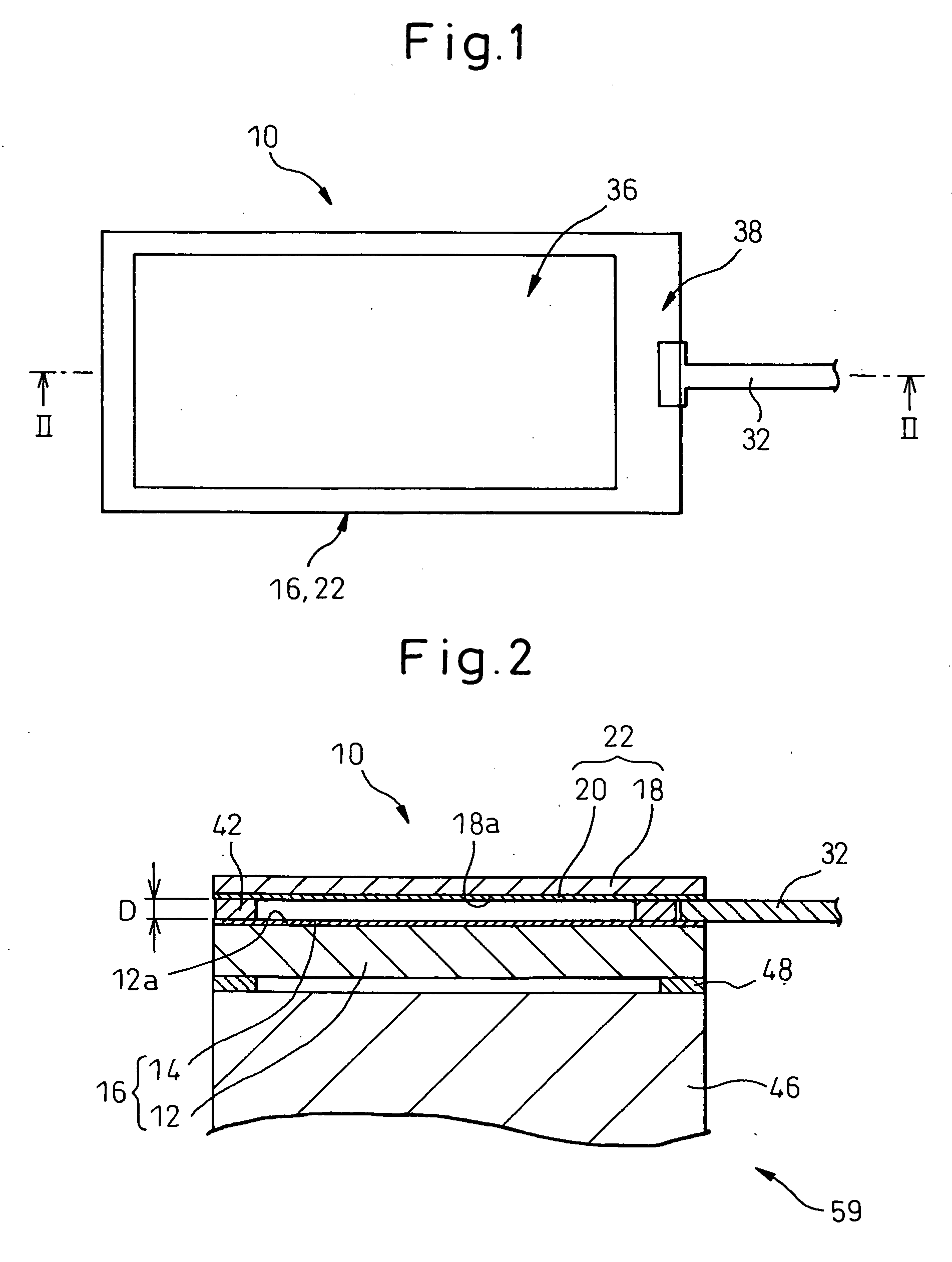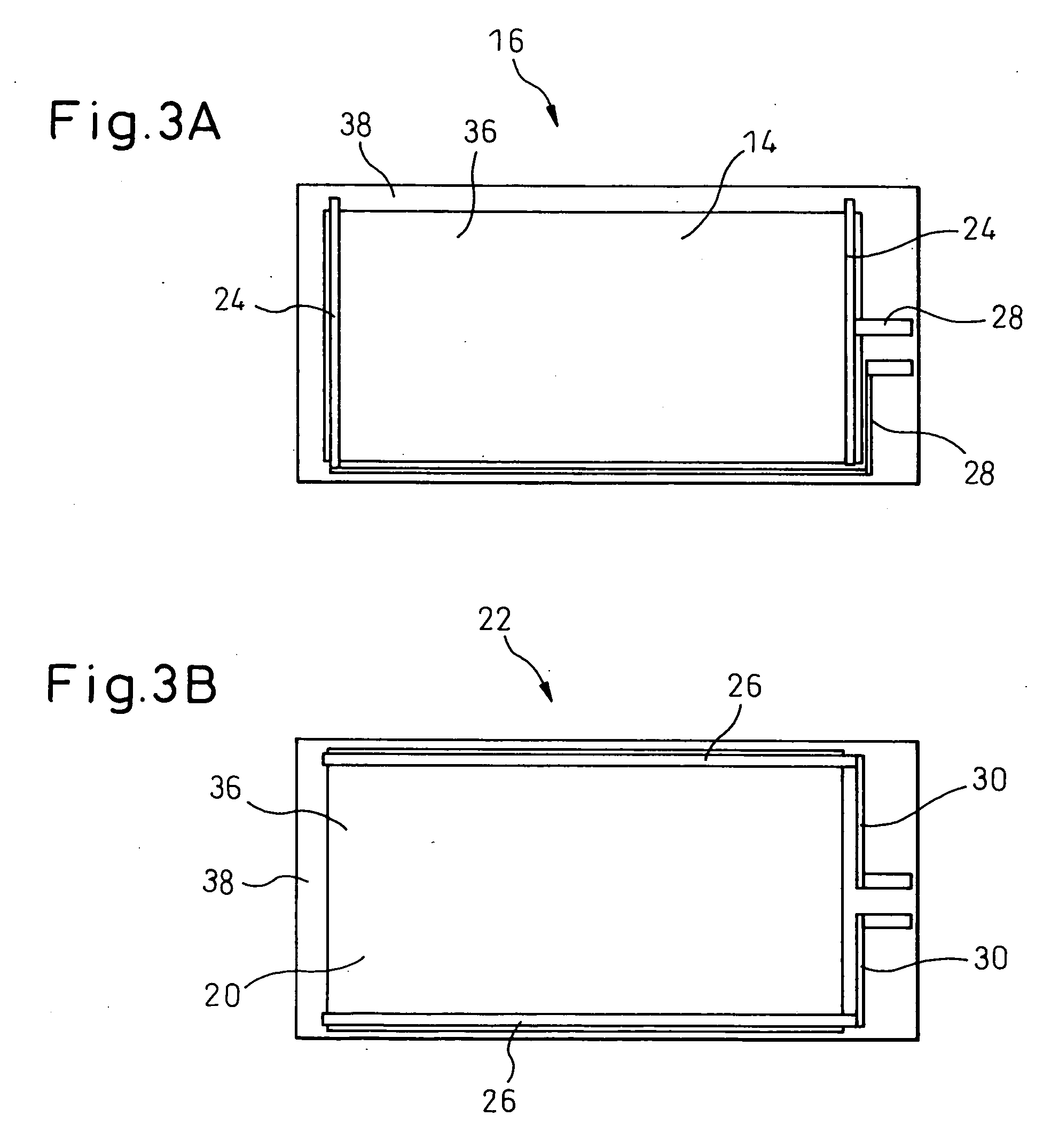Panel-type input device, method of manufacturing panel-type input device, and electronic apparatus having panel-type input device
a technology of input device and input device, which is applied in the manufacture of contact members, conductive layers on insulating supports, instruments, etc., can solve the problems of raising the manufacturing cost of the input device and achieve the effect of increasing the surface resistivity
- Summary
- Abstract
- Description
- Claims
- Application Information
AI Technical Summary
Benefits of technology
Problems solved by technology
Method used
Image
Examples
experiment 1
[Experiment 1]
[0087]As a sample of the electrode plate 16, 22 of the panel-type input device 10, an electrode plate (50 mm×60 mm) having a configuration in which a conductive coat (100 nm in thickness) formed from polythiophene-based conducting polymer (PEDOT / PSS) was coated onto a substrate (188 μm in thickness) formed from a PET film was prepared. The initial surface resistivity (pursuant to, e.g., JIS K6911) of the conductive coat of this electrode plate was 653Ω / □ (ohm / square). Then, the electrode plate was irradiated with ultraviolet light with 365 nm peak-wavelength including 245 nm wavelength and 1000 mW / cm2 irradiance, from a high-pressure mercury lamp, in the atmosphere containing 0.1 ppm-100 ppm ozone, in a direction vertical to the surface of the conductive coat, at a scan speed of 0.67 m / min, by using an ultraviolet light irradiator UVC-02516 (manufactured by USHIO Inc., Tokyo, Japan). The irradiance light quantity of ultraviolet light irradiated in a single scan (referr...
experiment 2
[Experiment 2]
[0089]In relation to the aforementioned sample of the electrode plate, a conductivity controlling agent selected from a group including an oxidizing reagent such as hypochlorous acid, chloric acid, nitric acid, nitrous acid, sulfuric acid, sulfurous acid, etc., and a basic reagent such as sodium hydroxide, potassium, ammonium, tetraethylammonium hydroxide, etc., was contacted with the conductive coat through the mask 56 (FIG. 5), so as to increase the surface resistivity of the desired region of the conductive coat. As a result, two regions having mutually different surface resistivity were successfully formed in the conductive coat, which can be used as the conductive coats 14, 20 of the electrode plates 16, 22 of the panel-type input device 10. In particular, a basic reagent containing 10% sodium hydroxide solution as a major component was excellent in a resistivity increasing function, and the surface resistivity of the desired region of the conductive coat was nece...
experiment 3
[Experiment 3]
[0090]The aforementioned sample of the electrode plate was prepared by modifying the conductive coat so as to be formed from polythiophene-based conducting polymer (PEDOT / PSS) containing 3% benzoyl peroxide. The initial surface resistivity (pursuant to, e.g., JIS K6911) of the conductive coat of this electrode plate was 698Ω / □ (ohm / square). Then, the electrode plate was irradiated with ultraviolet light with 365 nm peak wavelength and 1000 mW / cm2 irradiance, from a high-pressure mercury lamp, in a direction vertical to the surface of the conductive coat, at a scan speed of 5 m / min, by using the same apparatus as in Experiment 1. The irradiance light quantity of ultraviolet light in a single scan (referred to as a unit light quantity) was 500 mJ / cm2. FIG. 15 shows a mode of change in the surface resistivity of the conductive coat, measured through the repeated irradiation of the unit light quantity. As shown in FIG. 15, it has been proved that the surface resistivity of...
PUM
| Property | Measurement | Unit |
|---|---|---|
| Thickness | aaaaa | aaaaa |
| thickness | aaaaa | aaaaa |
| thickness | aaaaa | aaaaa |
Abstract
Description
Claims
Application Information
 Login to View More
Login to View More - R&D
- Intellectual Property
- Life Sciences
- Materials
- Tech Scout
- Unparalleled Data Quality
- Higher Quality Content
- 60% Fewer Hallucinations
Browse by: Latest US Patents, China's latest patents, Technical Efficacy Thesaurus, Application Domain, Technology Topic, Popular Technical Reports.
© 2025 PatSnap. All rights reserved.Legal|Privacy policy|Modern Slavery Act Transparency Statement|Sitemap|About US| Contact US: help@patsnap.com



